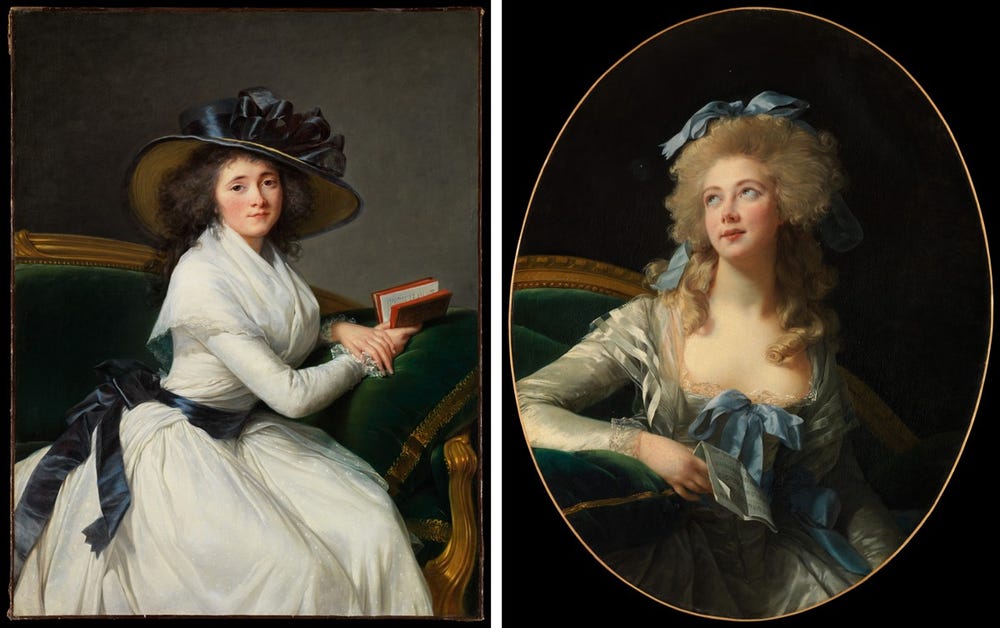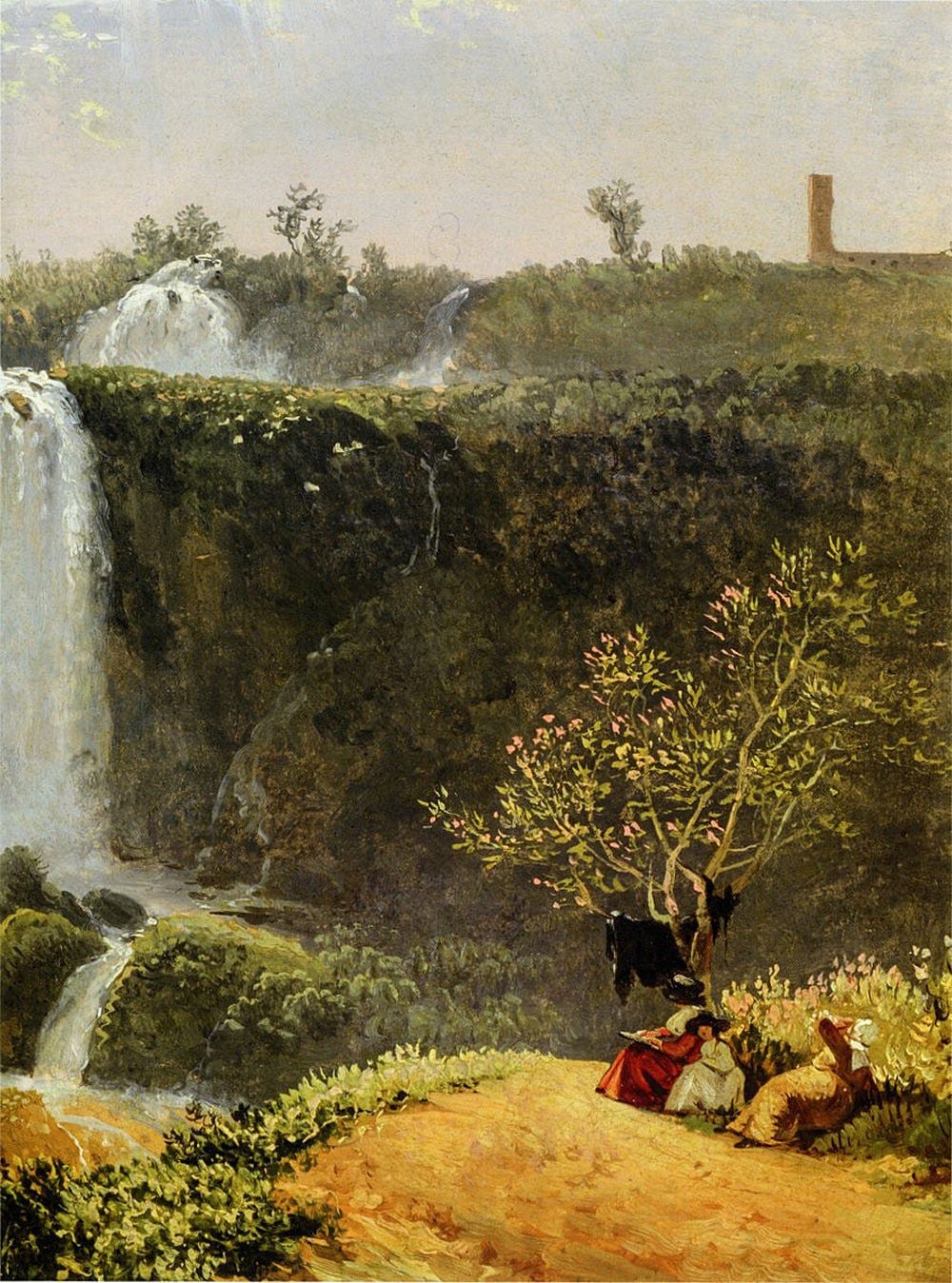Renewal Among the Ruins: Vigée Le Brun in Exile
By Isabella Holland
April 24, 2020
On October 5, 1789—just as the momentous Women’s March on Versailles was bringing the royal family of France face-to-face with the country's Third Estate—Élisabeth Louise Vigée Le Brun, portraitist to Queen Marie Antoinette, fled Paris. Aware of her precarious attachments to the monarchy, she would not return to France for another twelve years.
As a member of the Royal Academy (an institution that had supported and legitimized her career), Vigée Le Brun had developed a highly sought-after style of portraiture that affirmed the refined tastes of ancien régime society. However, once abroad, the artist confronted a new reality, and a new type of patroness.
Arriving first in Italy, a destination she chose for its strong artistic traditions, Vigée Le Brun needed to rebuild her art practice. She did this to support not only herself in her new life abroad but also her daughter, who had travelled with her, and her husband, art dealer Pierre Le Brun, who had remained in the French capital.
Elisabeth Louise Vigée-LeBrun, Hyacinthe Gabrielle Roland, 1791. Oil on canvas, 39 x 29 1/2 in. (99.1 x 74.9 cm). Fine Arts Museums of San Francisco, museum purchase, Mildred Anna Williams Collection, Bequest Fund of Henry S. Williams in memory of H.K.S. Williams, 1991.29
Socially and financially astute, Vigée Le Brun quickly acquainted herself with a community of emigrées whose patronage—now essential to her livelihood—she worked to secure. This international set comprised a strong contingency of British figures, diplomats, and collectors whose interests in Italy were rooted in politics and culture. These expatriates were interested in upholding alliances with Naples, the largest state in Italy, and were mad for Italian art, both old and new. It was most likely through this circle that Vigée Le Brun obtained one of her first commissions in exile: a three-quarter portrait of Hyacinthe Gabrielle Roland (above). Painted soon after Vigée Le Brun’s arrival in Rome from Florence in 1791, the portrait has been in the collection of the Fine Art Museums of San Francisco since 1991.
In her Souvenirs (Memoirs), Vigée Le Brun provides uncharacteristically little information about the circumstances that led to her portrait of Hyacinthe Gabrielle Roland: “Then I painted Mlle Roland, mistress at the time of Lord Wellesley, who was not long in marrying her.”
Roland, purportedly a French actress with the Palais Royal, was the mistress of Richard Wellesley, Earl of Mornington. At the time of her portrait, she was already the mother of his three children and they would eventually have two more together and marry in 1794. As the elder brother of the future Duke of Wellington, Wellesley had political and aristocratic credentials that no doubt placed him and Roland among the circle of British expatriates with whom Vigée Le Brun socialized in Italy.
Hyacinthe Gabrielle Roland marks a pivotal and transformative moment in Vigée Le Brun’s oeuvre. Gloriously windswept, Roland is freed from the domestic interiors and hair powder of the artist’s earlier portraits completed in France, as illustrated below. This noticeable shift in setting and costume reveals just how brilliantly—and quickly—Vigée Le Brun adapted her style while in exile. She exchanged the au courant fashions of the French court for the more relaxed tastes of this emigrée community, which were undoubtedly shaped by the classical art that they voraciously studied, visited, and purchased.
Élisabeth Vigée Le Brun, Madame Grand (Noël Catherine Vorlée, 1761–1835), 1783. Oil on canvas, 36 1/4 x 28 1/2 in. (92.1 x 72.4 cm). The Metropolitan Museum of Art, New York, Bequest of Edward S. Harkness, 1940. 50.135.2 (R) Élisabeth Vigée Le Brun, Comtesse de la Châtre (Marie Charlotte Louise Perrette Aglaé Bontemps, 1762–1848), 1789. Oil on canvas, 45 x 34 1/2 in. (114.3 x 87.6 cm). The Metropolitan Museum of Art, Gift of Jessie Woolworth Donahue, 1954, 54.182
Vigée Le Brun soon found her services greatly desired as she traveled between Rome and Naples. She was often intimately acquainted with her elite subjects and accompanied them on popular art excursions to the ruins of these artistically rich cities. Eventually, she captured their likenesses in compositions whose references to Greco-Roman styles validated the artist’s and subject’s shared love of the Italian peninsula.
Simon-Joseph-Alexandre Clément Denis, Elisabeth Louise Vigée-Le Brun drawing the cascade at Tivoli in the company of her daughter and governess, ca. 1790. Oil on paper laid on canvas, 11 3/8 x 8 5/8 in. (28.9 x 22 cm). Private collection
—Élisabeth Vigée Le BrunNot only did I find painting a great resource and enjoyment, surrounded as I was by works of art; but I had to rebuild my fortune. Luckily I had only to choose amongst the greatest personages the portraits I wished to take.
Élisabeth Vigée Le Brun, Lady Hamilton as a Bacchante, ca. 1790–1792. Oil on canvas, 52 1/8 x 41 ½ in. (132.5 x 105.5 cm). National Museums Liverpool, Lady Lever Art Gallery, LL 3527
In evaluating Vigée Le Brun’s prodigious body of Italian works, Lady Hamilton as a Bacchante (above), now in the collection of the Walker Art Gallery, most closely aligns in style and subject with our painting, Hyacinthe Gabrielle Roland. With its dynamic sky and the sitter’s twisting form set against it, Lady Hamilton as a Bacchante nearly replicates the compositional format of Hyacinthe Gabrielle Roland. Both sitters are fashioned in classicizing tunics, their luscious free-flowing hair enwrapping them. While Lady Hamilton as a Bacchante makes more pronounced allusions to antiquity—the subject is rendered in the guise of a reveling bacchante, as the ever-present Mount Vesuvius erupts in the background—the energizing force of Italy abounds in both portraits. Read Vigée Le Brun’s own account of visiting the volcano.
It was through Sir William Hamiltion, the British envoy to Naples and an art collector and dealer, that Vigée Le Brun met Emma Hart, the subject of Lady Hamilton as a Bacchante. Hart was the mistress, and later wife, of Hamilton, who approached Vigée Le Brun for the portrait. Vigée Le Brun’s memoirs reveal that she was instantly enraptured by Hart:
—Élisabeth Vigée Le BrunNothing in fact was more curious than to watch the facility which Lady Hamilton had of expressing in her features either joy or sorrow, and of imitating different persons. . . . I was enchanted.
Élisabeth Vigée Le Brun, Life Study of Lady Hamilton as the Cumaean Sybil, 1792. Oil on canvas, 28 3/4 × 22 1/2 in. (73 × 57.2 cm). Private collection
Beyond being her model, Hart was also Vigée Le Brun’s friend. The artist would go on to paint her numerous times, most importantly in Lady Hamilton as the Cumaean Sybil (above), which Vigée Le Brun would use as a reception piece in her introduction to the courts of Vienna and Russia, where she later took refuge.
Vigée Le Brun’s Memoirs is a useful account for understanding how her sympathetic attitudes toward mistresses such as Roland and Hart influenced her artistic approach to Hyacinthe Gabrielle Roland. In many ways, the three women’s biographies testify to a shared experience of exile in Italy. Hart was brought to Naples by Hamilton’s nephew (of whom she was originally the mistress) to escape public scrutiny in England. Roland likely faced a similar experience of social exile, and even after her legitimizing marriage to Wellesley, she did not travel with him to India when he was made governor-general.
While Italy epitomized Vigée Le Brun’s political banishment, it was also a backdrop for her opportunity. Although she faced the threat of financial distress there, she also had greater control over her earnings (in Paris, her husband had collected them). She ardently visited museums where she could see the work of Italian masters like Raphael, whose paintings effected a renewal in her own art. Italy exposed Vigée Le Brun to women similarly displaced from their home countries, and her portraits of them not only publicized her artistic skill but also enabled these otherwise hidden women to become visible.
Text by Isabella Holland, Curatorial Assistant, European Paintings at Fine Arts Museums of San Francisco.
Holland chats about how she would like to be painted by Vigée Le Brun in this video.
Learn more about European painting at the Legion of Honor.
Further reading:
Élisabeth Vigée Le Brun, Souvenirs, 1880: R.Worthington, New York.









